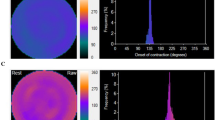Summary
Digital angiography provides a convenient means to quantify the progression of a contrast medium bolus injected into a coronary artery throughout the myocardium, which in turn yields information on myocardial perfusion. Sixteen patients presenting a single critical proximal stenosis (estimated diameter reduction >80%) on either the left anterior descending coronary artery (LAD) or the left circumflex coronary artery (LCX) were studied. First, 12 consecutive end-diastolic images of an ECG-triggered intracoronary injection of 4 ml of iopamidol were acquired on 60° left anterior oblique projection under basal conditions. This was repeated 30 s after intracoronary injection of 12 mg of papaverine. For each image sequence, a densogram was computed in each pixel by fitting a curve through its 12 consecutive intensity values. The ‘time of maximal pixel opacification’ (TMAX) and the ‘mean ascending time’ (TMAT), expressed in cardiac cycles, were determined from each curve. Two myocardial regions of interest (ROI) were defined for each patient, one in the perfusion bed of the LAD, the other in the bed of the LCX. The mean values of TMAX and TMAT in each ROI were computed, at rest and during hyperemia. At rest, the mean values of TMAX and TMAT obtained from the ROI associated to the stenosis artery were not significantly different from the values obtained in the ROI associated with the intact artery. During hyperemia, a significant decrease of the mean TMAX and TMAT was observed in the normally perfused regions (p<0.001). The rest to hyperemia ratios of both TMAX and TMAT mean values were considered to be indices of coronary flow reserve. Due to the decrease of TMAX and TMAT during hyperemia, the two indices were significantly higher in the normal ROI than in the ischemic ROI (p<0.001).
In conclusion: Intracoronary injection of papaverine produces an acceleration of blood flow in normally perfused myocardium despite the increase of vascular volume. This acceleration is absent in regions supplied by a severely stenosed coronary artery. Thus, a differentiation between normally and abnormally perfused myocardial regions is possible by use of indices of coronary flow reserve derived from time parameters of the myocardial circulation.
Similar content being viewed by others
References
Detre KM, Wright E, Murphy ML, Takaro T. Observer agreement in evaluation of coronary angiograms. Circulation 1979; 52: 979–986.
Zir LM, Miller SW, Dinsmore RE, Gilbert JP, Hawthorne JW. Interobserver variability in coronary angiography. Circulation 1976; 53: 627–32.
De Rouen TA, Murray JA, Owen W. Variability in the analysis of coronary angiogram. Circulation 1977; 55: 324–328.
Meier B, Gruentzig AR, Pyle R, von Gosslar W, Schlumpf M. Assessment of stenosis in coronary angioplasty. Inter- and intraobserver variability. Intern J Cardiol 1983; 3: 159–169.
Vas R, Eigler N, Miyazono C, Pfaff JM, Resser KJ, Weiss M, Nivatpumin T, Withing J, Forrester J. Digital quantification eliminates intraobserver and interobserver variability in the evaluation of coronary artery stenosis. Am J Cardiol 1985; 56: 718–723.
Grondin CM, Dyrda I, Pasternac A, Campeau L, Bourassa MG, Lespérance J. Discrepancies between cineangiographic and postmortem findings in patients with coronary artery disease and recent myocardial revascularization. Circulation 1974; 49: 703–708.
van der Werf T, Heethaar RM, Stegehuis H, Meijler FL, van der Mark M. The concept of apparent cardiac arrest as a prerequisite for coronary digital subtraction angiography. J Am Coll Cardiol 1984; 4: 239–244.
Rutishauser W, Bussmann W, Noseda G, Meier W, Wellauer J. Blood flow measurements through single coronary arteries by roentgen densitometry. Part I and II. Am J Roentgenol 1970; 109: 12–24.
Rutishauser W, Simon H, Stucki J, Schad N, Noseda G, Wellauer J. Evaluation of roentgen densitometry for flow measurement in models and in the intact circulation. Circultion 1967; 36: 951–963.
Bürsch JH, Heintzen PH. Parametric imaging. Radiologic Clinics of North America 1985; 23: 321–333.
Harrison DG, White ML, Hiratzka LF, Doty DB, Barnes DH, Eastham CL, Marcus ML. The value of cross sectional area determined by quantitative coronary angiography in assessing the physiologic significance of proximal left anterior descending coronary arterial stenosis. Circulation 1984; 69: 1111–1119.
Gould KL, Lipscomb K, Hamilton GW. Physiologic basis for assessing critical coronary stenosis. Am J Cardiol 1974; 33: 87–94.
Klocke FJ. Measurements of coronary blood flow and degree of stenosis: Current clinical implications and continuing uncertainties. J Am Coll Cardiol 1983; 1: 31–41.
Vogel RA, LeFree M, Bates E, O'Neill W, Foster R, Kirklin P, Smith D, Pitt B. Application of digital techniques to selective coronary arteriography: Use of myocardial contrast appearance time to measure coronary flow reserve. Am Heart J 1984; 107: 153–164.
Zijlstra F, Serruys PW, Hugenholtz PG. Papaverine: The ideal vasodilator for investigating coronary flow reserve? A study of timing, magnitude, reproducibility and safety of the coronary hyperemic response after intracoronary papaverine. Cathet Cardiovasc Diagn 1986; 12: 298–303.
Wilson RF, White CW. Intracoronary papaverine: An ideal coronary vasodilator for studies of the coronary circulation in conscious humans. Circulation 1986; 73: 444–451.
Marchant E, Pichard A, Rodriquez JA, Casanegra P. Acute effect of systemic versus intracoronary dipyridamole on coronary circulation. Am J Cardiol 1986; 57: 1401–1404.
Nissen SE, Elion JL, Booth DC, Evans J, DeMaria AN. Value and limitations of computer analysis of digital subtraction angiography in the assessment of coronary flow reserve. Circulation 1986; 73: 562–571.
Hodgson JMcB, LeGrand V, Bates ER, Mancini GB, Aueron FM, O'Neill WW, Simon SB, Beauman GJ, LeFree MT, Vogel RA. Validation in dogs of a rapid digital angiographic technique to measure relative coronary blood flow during routine cardiac catheterization. Am J Cardiol 1985; 55: 188–193.
Cusma JT, Toggart EJ, Folts JD, Peppler WW, Hangiandreou NJ, Lee CS, Mistretta CA. Digital subtraction angiographic imaging of coronary flow reserve. Circulation 1987; 75: 461–472.
Author information
Authors and Affiliations
Additional information
Supported by a grant of the Swiss National Science Foundation.
Rights and permissions
About this article
Cite this article
de Bruyne, B., Dorsaz, P.A., Doriot, P.A. et al. Assessment of regional coronary flow reserve by digital angiography in patients with coronary artery disease. Int J Cardiac Imag 3, 47–55 (1988). https://doi.org/10.1007/BF01801644
Issue Date:
DOI: https://doi.org/10.1007/BF01801644




